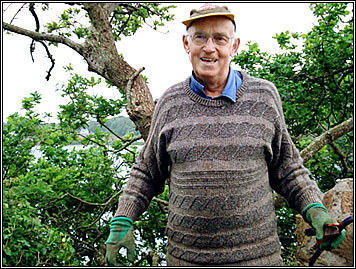 |
As
said in the last edition, the article published about the genus
Pseudolaelia should include an interview with Michel Frey
talking about his researches in Brazil. Unfortunately, he passed
away letting a lacuna to his family, friends, admirers and researchers
of Orchidaceae family.
Thus, we stayed waiting for, as a happy coincidence, for finding
the interview in his HD and then we could have the "gros repas"
he promised. His family, mainly his daughter Julia Seitre, made
every effort in this search and, kindly, allowed the publication
of it, as well as the photographs for illustrating. Although unfinished,
we decided to show it as a small homage to him.
In this edition, two more species discovered and described by him
are presented, kindly authorized by 'Richardiana', through the editor,
Guy Chiron. |
ON:
Michel, could you do a little profile of you? Talk a little about
your history.
MF: I was born in Mulhouse, in the east of France (Alsace), next
to the frontier of Switzerland and Germany, 72 years ago, in an
textile industrialist family.
When I was 5, I should run away with my mother and my sister, due
to the german invasion. My father has been arrested by the invaders
and we were sheltered in a house of my mother's aunt, in the center
of France. I stayed there for 5 years in a small farm where I learnt
loving the nature. We were in the middle of the country, in calcareous
region where there were many orchids.
After the war, I came back to Alsace where I completed my studies
and then I went to Paris. I was graduated by the Ecole Polytechnique
(Polytechnic College), the biggest College for engineering in France
but I decided to follow a career in a bank. After two years, I realized
that it was not my way and changed to the industry where I stayed
for 40 years. I started in Dakar (Senegal), with my young wife Marine,
and then we came back to Alsace where I stayed. We had two boys
and two girls and I retired in 1996, always interested in orchids.
ON: How did you become interested in orchids?
MF: I always love the nature and, coming back to Alsace, I discovered
in my grandmother's house, many books about tropical orchids owned
by my great-grandmother. Little by little, I fell in love.
In Paris, I had the first contacts with the local orchidists.
When I invited to a ball, I used to offer to my partner orchids
to adorn her dress.
In 1947, my father built a small nursery on the garden and I started
to cultivate Odontoglossums, Coelogynes, Cymbidiums. For my 24th
anniversary, my parents offered me a Vanda coerulea.
I also started to travel, specially to tropical countries where
I was luck to find orchids.
In 1964, we built our own house and the most important room was
the nursery! My collection grew and, by 1990, I had at about 1.800
plants, some bought or exchange but most of them brought during
the travels.
ON: And how Brazil came to your history?
MF: I came to Brazil, for the first time in 1984 and I discovered
the Pleurothallis, Stelis and Octomeria what
I still love very much. When I retired, I though about starting
an activity of reforest with native trees. I bought a small farm,
in mountain, in Venda Nova do Imigrante, where my son already lived
since 5 years.
Soon my interest in orchids grew, specially after meeting Roberto
Kautsky, Erico Machado, Wladyslaw and Savio.
ON: Since when are you studying Pseudolaelia and since
then are doing field works?
MF: My first contact with Pseudolaelias was precisely in Monte Feio
(Brejetuba, Espírito Santo), in 2000, where I had the pleasure
to discover an orchid that seemed to me a new one.
I was with my dear friend Luiz C.F. Perim and him, as younger, walking
50 meters ahead. I said: "- Luiz, it is possible to find Pseudolaelias
here. Look carefully the Vellozias and Nanuzas".
Five minutes after, Luiz shouted :" -There is one!"
I said : "-Do not touch, please. It can be the only one".
I got closer and saw that it was, by the appearance, a Pseudolaelia
without flowers and we went on climbing. Soon after, we were in
a field of thousands Pseudolaelias, with old floral stems. Immediately,
I discovered a smaller plant, quite different, with very aggregated
pseudobulbs, with paniculate floral stems that was really another
thing.
We came back many times to Monte Feio, until found plants blooming.
The ordinary species, we identified as Pseudolaelia dutrae
Ruschi and the other, for sure, was unknown.
By this time, I didn't have experience how to publish a new species.
I asked many friends in France and, little by little, I succeeded
in finishing, with Claudio Nicoletti de Fraga's precious help, the
description of this new species which has been published in Bradea.
I became immortal. What could I desire more? |
ON:
Which habitats did you visit or still visit and what could you give
as information about them?
MF: After that, I was luck to discover 3 new species of Pseudolaelia,
always with Luiz (Carlos Perim), who visits, untiring, all 'morros'
(mountains) of Espírito Santo and the closest in Minas Gerais:
Pseudolaelia maquijiensis, in the ''Morro do Maquiji, next
to Baixo Guandu (ES), Pseudolaelia pavopolitana, in the Morro
do Cruzeiro, next to Vila Pavão (ES) and - it deserves to
be related - Pseudolaelia so ordinary in Monte Feio, that
we had identified as P. dutrae, it was not!
Months later, walking through Morro do Maquiji, we found a pink
very beautiful Pseudolaelia which were, no doubt about.
dutrae. With the help of the Museu de Biologia Mello Leitão
de Santa Teresa (ES) we got the original description of Pseudolaelia
dutrae, done by Augusto Ruschi: nothing similar. |
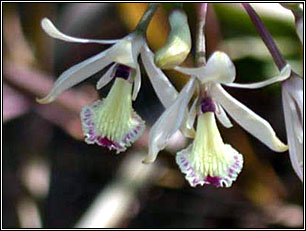 Pseudolaelia
freyi
Pseudolaelia
freyi |
So,
this ordinary plant that the local orchidists knew and named as
P. dutrae, was a new species ! Due to the demanding of many
friends, I asked Vitorino and Guy Chiron for doing the publication.
Thus, the plant was named Pseudolaelia freyi.
I still don't know if becoming twice immortal is better than one
! |
Besides,
once again in Monte Feio, Luiz discovered a odd plant which had
characteristics from P. brejetubensis and Pseudolaelia
freyi. Soon, it became evident that it was a natural hybrid
from those two plants. I published it under the name of Pseudolaelia
x perimii. |
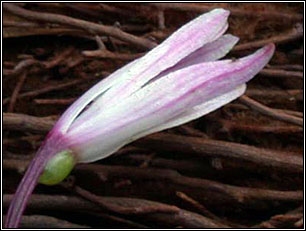
P. brejetubensis |
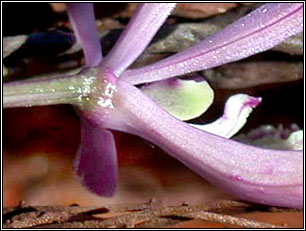
P. freyi. |
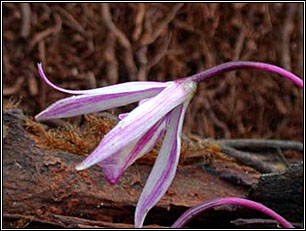
Pseudolaelia x perimii
|
Having
meeting Guy Chiron during the preparation of the WOC in Dijon, I
decided, since then, to publish in Richardiana, because the magazine
could print color photos which was, of course, better.
(Note: The species mentioned are presented in Orchid
News # 29). |
|
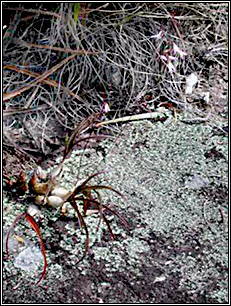 |
Pseudolaelia
freyi habitat in Monte Feio |
ON:
So, you discovered 5 new species, don't you?
MF: We discovered Pseudolaelia maquijiensis in morro de Maquiji,
between Colatina and Baixo Gandu (ES). Many reports, not yet confirmed,
indicate that there are yellow Pseudolaelias in the region of Santa
Maria de Jetibá. I would like to point out that there are
three yellow species.
Pseudolaelia canaanensis (ex Renata), very
big, scented, very paniculate and without lateral lobes, Pseudolaelia
maquijiensis and Pseudolaelia citrina, discovered by
Roberto Kautsky 30 years ago, in Pedra Santa (Mutum, MG).
This species has an area of distribution at about some hectares
and have never been found in another place. it is surprising that,
in this context, P. brejetubensis should be found in Monte
Feio (Brejetuba, ES) and not in the next morro and has been found
by Wlad in Pedra da Invejada (Mutum, MG ) which is, at about, 15
km bird flight.
ON: Are there still new thing to be discovered?
MF: For sure, there is many things to be discovered inside this
genus. The problem is climbing the morros which are, sometimes,
inaccessible.
ON: In your field researchers, did you only discover species
from this genus?
MF: After that, I published two more species: Myoxanthus conceicioensis,
a small plant discovered next to Conceição do Castelo,
by Nelson Samson, an excellent expert and orchids researcher of
the region and Epidendrum josianae, a very big Epidendrum
, found in Pedra Santa, next to Ibiruçu (MG).
About this plant, there is a doubt. Eric Hagsáter, the pope
of Epidendrums thinks that it is similar to Epidendrum kautskyi.
As I have, thank to Roberto Kautsky, a good knowledge of E. kautskyi
and still have two related plants to study, I prefer letting
this subject suspended until collecting material to be sure.
(...)
Luiz Carlos
Feitosa Perim, Michel Frey's friend and traveling companion
in his excursion through the habitats from Espírito Santo
and some from Minas Gerais, tells a little about the partnership.
ON: How was your friendship with Michel Frey?
LCP: I
had the privilege of meeting and being Michel's friend, organizing
and bringing him to visit all habitats of pseudolaelias. I really
miss him! Besides not having him as companion to excursions, when
I find something new, I don't have him to clarify my doubts. I wish
I will meet Wlad and Alek more. All new pseudolaelias have been
collected together, and as I am younger, I always went the first
and in the more dangerous place, I had the luck of finding them
before Michel. The last one, Pseudolaelia pavopolitana had
a different history. When talking with Euclidio Colnago, Wladyslaw
and Luciano Zappi, we got to know about Pedra do Cruzeiro, in Pavão
Village (north of the state), habitat of Encyclia espiritossantensis.
It was a very well know place, already visit for all botanists and
orchidists (besides those above mentioned, Ruschi, Kautsky, etc...
visited there). As I hade drunk some beers the evening before, I
decide not to climbing the rock in order to spare my self and stayed
resting, at the foot of this while Michel, with an enormous exhaustion
climbed until the peak. As he was lingered, I decided to do a stroll
around the rock when I discovered, blooming, the wonderful Pseudolaelia
pavopolitana, soon described by Michel. It comes to be the only
one tricolor inside the genus.
ON: What could you point out about those excursions?
LCP: We found, for example, Pseudolaelia geraensis also
in the state of Espírito Santo, more specifically in the
extreme northwest of the state, in the boundaries of the state of
Minas Gerais e Bahia.
ON: This is a new
concurrence. What about Minas Gerais?
LCP: We
visit the habitat of Pseudolaelia geraensis, next
to Governador Valadares, in Minas Gerais, on inselbergs, at 300
m or less.
ON: You have found another species in Espírito Santo about
what you are not sure.
LCP: For not arising polemics, we classified as Pseudolaelia
vellozicola, but Michel and Vitorino (Paiva Castro Neto) pointed
out two differences: not to grow on velozias and having the lobes
of really different from the known velozicolas. Is it a new species?
The habitat is placed at 600 m. altitude, in inselberg in the state
of Espírito Santo, 7 km far from the coast. It occurs among
the velozias, and does not accept competition of other vegetal species.
ON: What could you say about the habitat of Pseudolaelia freyi?
LCP: It
occurs between vellozias and nanuzias, in 1200 m altitude in inselberg
(granitic outcrop), in Monte Feio, Brejetuba, in the state
of Espírito Santo.
ON: And what
about the Pseudolaelia brejetubensis?
LCP: It is the same, at the same
altitude, in
inselberg (granitic outcrop) at the edges of the lathosol plaques.
ON: Which another species occur in Monte Feio?
LCP: There is also the
natural hybrid Pseudolaelia x perimii (Pseudolaelia
freyi e Pseudolaelia
brejetubensis) as
well
as Pseudolaelia canaanensis (ex-Renata canaanensis).
ON:
And in the boundaries of Minas Gerais and Espírito that you
have already visited?
LCP: In
Pedra Santa (Mutum), at 1100 m altitude, occurs the Pseudolaelia
corcovadensis. It is also the habitat of the endemic (at
least at the present time) Pseudolaelia
citrina discovered by Kautsky.
ON:
Thank you, Luiz Carlos.
|
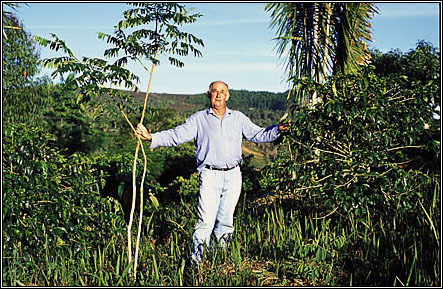
Michel Frey, engineer and environmentalist, founded, in 1999,
with his family and friends, the INSTITUTO JACQUES WALTER to reforest
Atlantic Forest, re-introduce and develop the native fauna and
flora.
With the head office placed in Venda Nova do Imigrante city, this
institution develops projects of reforestation with native trees,
makes registers and drawing of botanical species, promoting different
census and environmental education between many other activities.
The lands owned by the institution are placed in the sources of
Rio Castelo river, tributary of Itapemirim river, in the boundaries
of the municipalities of Conceição do Castelo and
Brejetuba, at about 1100m altitudes. Besides de the conservation
of the natural remained areas, 400.000 native trees have been
planted during the last years, in old areas before reserved to
the culture of eucalyptus and to pasture. Between the activities
which are currently developed, some should be that should be pointed
out such as the execution of more than 350 scientific illustrations
plates of orchids from Espírito Santo, ornithological census
registering the occurrence of more than 200 species of birds and
reception of authorities, communities, environmentalists, photographers
and Brazilian or foreign scientists.
INSTITUTO JACQUES WALTER
Av Domingos Perim,nº 563
Venda Nova do Imigrante - ES
Cep 29375-000
E -mails: freypierre@tiscali.it
e lcfperim@veloxmail.com.br
Acknowledgments:
Luiz Carlos Feitosa Perim, de Vitória - ES
|
|

